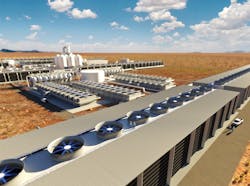Occidental starting work on Direct Air Carbon Capture project in oil-rich Permian Basin
Oil and gas producer Occidental and its decarbonization subsidiary 1PointFive will start the construction of their first large-scale Direct Air Capture (DAC) plant for carbon capture in Ector County, Texas.
It will be the world’s largest of its kind and contribute to Occidental’s low-carbon strategy, the petroleum company says. Ector County is deep within the heart of the massive, productive Permian Basin oil field region.
The new plant is expected to capture up to 500,000 metric tons of CO2 annually. The carbon capture capacity is expected to increase to as much as 1 million metric tons per year, gradually.
The first stage of construction, which includes site preparation and road work, is expected to start in the third quarter of 2022. Operations are expected to begin in late 2024.
The captured CO2 from the new DAC plant will be sequestered deep underground in saline formations or used for hydrocarbon production. The advanced product sales for the plant include carbon removal credit purchase agreements with Airbus, Shopify and ThermoFisher and an offtake agreement with SK Trading International to buy net-zero oil.
Additionally, Occidental will buy zero-emission solar power for the plant and other projects in the Permian Basin from Origis Energy.
“Construction of this transformative facility begins our journey toward providing commercial-scale DAC solutions that reduce and remove carbon emissions,” said Richard Jackson, President, U.S. Onshore Resources and Carbon Management, Operations, Oxy. “This plant’s development is rooted in our carbon management expertise, strong record of delivering major projects and existing infrastructure that supports the commercialization of carbon capture, utilization and storage technologies. This plant could also anchor future low carbon projects and strengthen our portfolio of carbon management solutions.”
See more EnergyTech coverage of Carbon Capture Projects
CO2 Avoided is Decarbonization: Our full slate of Energy Efficiency stories
Subscribe to the free, tri-weekly email newsletter for more Insights into the C&I Energy Transition
1PointFive has signed up Worley for engineering, procurement and construction services and partnered with climate solutions firm Carbon Engineering to commercialize and deploy DAC technology at scale. The plan is to deploy 70 DAC facilities worldwide by 2035.
The project is expected to employ more than 1,000 people during the construction phase and up to 75 once operational. The Inflation Reduction Act’s increased incentives will further accelerate DAC deployment as a solution to help achieve net zero, according to the company release.
Two years ago, Oxy Low Carbon Ventures joined with private equity firm Rusheen Capital Management to form the 1PointFive joint venture around DAC development and deployment. Oxy already has been permanently storing CO2 for more than 40 years, with nearly 20 million metric tons sequestered in its operations annually.
About the Author
EnergyTech Staff
Rod Walton is senior editor for EnergyTech.com. He has spent 17 years covering the energy industry as a newspaper and trade journalist.
Walton formerly was energy writer and business editor at the Tulsa World. Later, he spent six years covering the electricity power sector for Pennwell and Clarion Events. He joined Endeavor and EnergyTech in November 2021.
He can be reached at [email protected].
EnergyTech is focused on the mission critical and large-scale energy users and their sustainability and resiliency goals. These include the commercial and industrial sectors, as well as the military, universities, data centers and microgrids.
Many large-scale energy users such as Fortune 500 companies, and mission-critical users such as military bases, universities, healthcare facilities, public safety and data centers, shifting their energy priorities to reach net-zero carbon goals within the coming decades. These include plans for renewable energy power purchase agreements, but also on-site resiliency projects such as microgrids, combined heat and power, rooftop solar, energy storage, digitalization and building efficiency upgrades.
